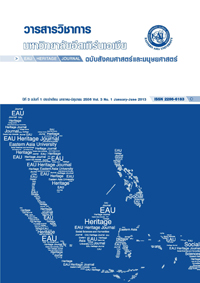รูปแบบการบริหารเพื่อการเปลี่ยนแปลงวัฒนธรรมองค์การ ที่เอื้อต่อการเรียนรู้ในสถานศึกษาการศึกษานอกระบบ และการศึกษาตามอัธยาศัย
คำสำคัญ:
รูปแบบการบริหารเพื่อการเปลี่ยนแปลง, วัฒนธรรมองค์การที่เอื้อต่อการเรียนรู้, สถานการศึกษานอกระบบ, model for changing organizationalบทคัดย่อ
การวิจัยนี้ศึกษาองค์กรที่เอื้อต่อการเรียนรู้ในสถานศึกษาการศึกษานอกระบบและการศึกษาตามอัธยาศัย มีวัตถุประสงค์เพื่อ (1) ศึกษาวัฒนธรรมองค์การ (2) ศึกษาปัจจัยที่ส่งผลให้เกิดวัฒนธรรมองค์การและ (3) นำเสนอ รูปแบบการบริหารเพื่อการเปลี่ยนแปลงวัฒนธรรมองค์การที่เอื้อต่อการเรียนรู้ในสถานศึกษาการศึกษานอกระบบ และการศึกษาตามอัธยาศัย ประชากรในการศึกษาได้แก่ สถานศึกษานอกระบบและการศึกษาตามอัธยาศัยอำเภอ/ เขต จำนวน 927 แห่ง จาก 76 จังหวัด กลุ่มตัวอย่าง จำนวน 280 แห่ง ผู้ให้ข้อมูล ได้แก่ ผู้บริหาร เจ้าหน้าที่ บุคลากร ครู วิทยากรผู้สอน จำนวน 840 คน เครื่องมือที่ใช้ในการวิจัย คือ แบบสอบถาม การสัมภาษณ์เชิงลึก สถิติที่ใช้ในการวิจัยได้แก่ ค่าร้อยละ ค่าเฉลี่ย ค่าเบี่ยงเบนมาตรฐาน ค่าสัมประสิทธิสหสัมพันธ์ การถดถอย พหุคูณ ค่ามัธยฐาน ค่าพิสัยระหว่างควอไทล์ ผลการวิจัย พบว่า (1) สภาพวัฒนธรรมองค์การที่เอื้อต่อการเรียน รู้มีแบบแผนทางความคิด ความเชื่อ และค่านิยมที่มีลักษณะเอื้อต่อการที่ผู้ปฏิบัติงานร่วมกันอยู่ในระดับมาก ด้านการทำงานร่วมกันเป็นทีม (2) ปัจจัยที่ส่งผลให้เกิดวัฒนธรรมองค์การที่เอื้อต่อการเรียนรู้ ได้แก่ การแลกเปลี่ยน เรียนรู้ ปัญญา อารมณ์ สังคมของผู้บริหาร การนำความรู้ไปใช้ การแสวงหาเพื่อสร้างความรู้ ความถูกต้องทันสมัย ของข้อมูล ศีลธรรมคุณธรรม ประชาธิปไตยของบุคลากร เป็นกลุ่มตัวแปรที่ดีในการพยากรณ์ (3) รูปแบบการบริหาร เพื่อการเปลี่ยนแปลงวัฒนธรรมองค์การที่เอื้อต่อการเรียนรู้ในสถานศึกษาการศึกษานอกระบบและการศึกษา ตามอัธยาศัย ประกอบด้วยปัจจัยนำเข้า ได้แก่ ผู้บริหาร สิ่งแวดล้อม บุคลากร ทรัพยากรด้านเทคโนโลยี และ กระบวนการบริหารเพื่อการเปลี่ยนแปลงวัฒนธรรมองค์การที่เอื้อต่อการเรียนรู้ประกอบด้วย ผู้บริหารต้องจัดการ ตนเองเพื่อเป็นผู้นำการเปลี่ยนแปลง การจัดการกับสิ่งแวดล้อมและสร้างบรรยากาศ การจัดการกับบุคลากร การจัดการวางระบบและโครงสร้างองค์การ
A Management Model for Change on Organizational Culture Fuciliting Students’ Ability in the Non-Formal and Informal Education Institutions
This research aims to study learning in Non-Formal and Informal Education Institutions the organizational culture enhancing toward the (2) the factors that result in organizational culture enhancing toward the learning, and (3) propose the management model for changing organizational Culture. The populations were 927 non-formal and informal education Institutions from 76 provinces using 280 samples of the total population. The key informants were 840 people of administrators-director, staffs, employee, teachers and trainers from Non-formal and informal education institutions. The instruments used for the research were questionnaires and In-dept interviews. Statistics for this research were percentage, mean, standard deviation, correlation coefficients, multiple regression analysis, the median and inter quartile ranges. The research findings were as follows: (1) The organizational culture enhancing toward good learning consisting education institutions have the model of opinion, beliefs and attitude that looks conducive to good learning by administrators-director, government employees staffs teachers narrator students and users that take actions together. This is how it works. Conduct and performance together to bring about learning at a high level. Aspect of practice is higher than other areas of working together as a team. But aspect of the leadership role of teaching tasks to the worker is the lower the performance of others. (2) The factors that result in the organizational culture enhancing toward the learning 6 variables: exchange learning intellectual emotional social of administrators-director adaptation of knowledge to use search for new knowledge creation accuracy of data moral virtues and democracy of staff. (3) The model consists of input, including administrators-director, environmental, technology, staff and the management process the administrators-director must manage their own to be leader changing, the management with the environment and atmosphere, the management personnel, and the management system and organizational structure.




